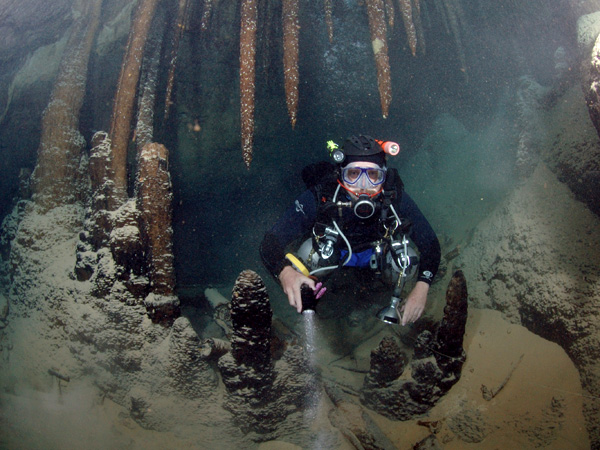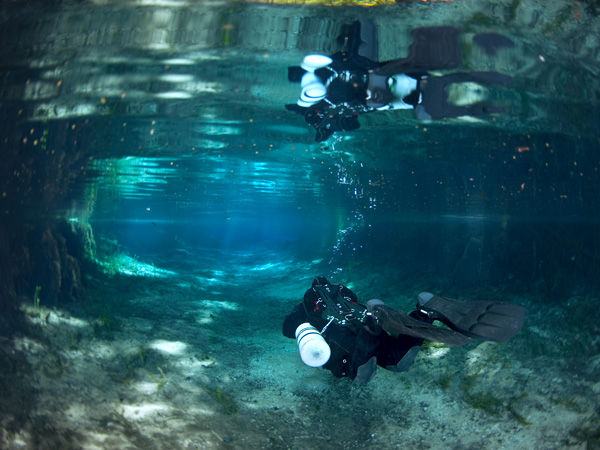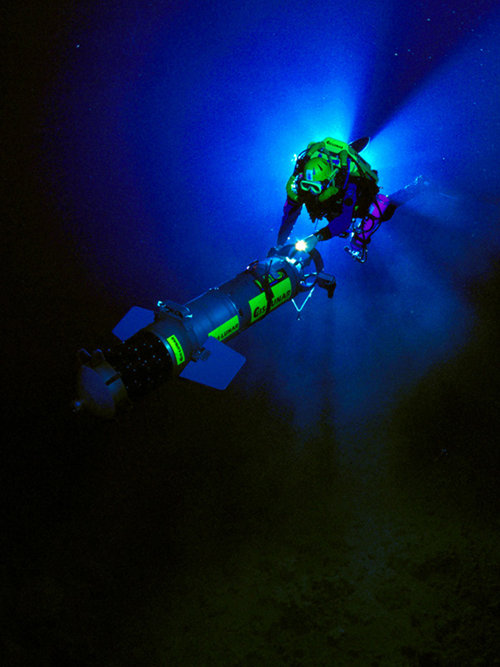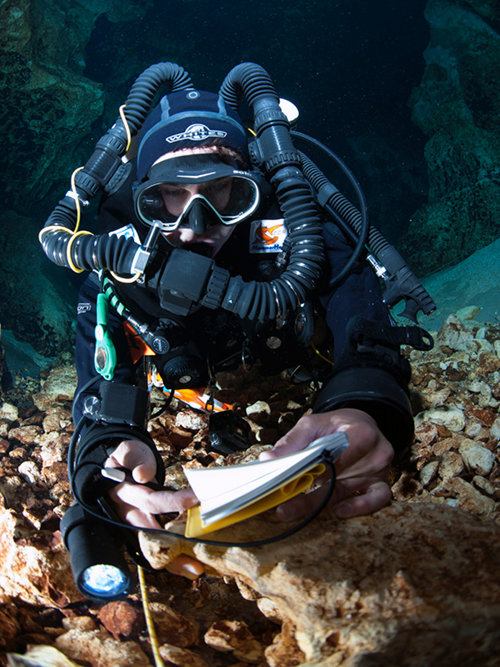
By Jill Heinerth, Underwater Videographer - www.IntoThePlanet.com
The evolution of underwater cave exploration has been rapidly expanded through the use of new technologies, increased availability of reliable equipment and globally available training experiences. World record penetration dives of two decades past are now being conducted as routine excursions. Exploration has moved from wide open passages into tight, secluded sites, highly technical expeditions, remote locations and sump dives to previously unimaginable depths. Beyond stretching the limits of human endeavor, cave diving exploration has led the ranks of serious “technical diving.” Three factors have contributed to increased range and productivity within cave diving exploration: global availability of training and mentoring, improved quality and availability of cave diving equipment and the development of advanced technologies for exploration. The Bermuda Deep Project brings together some of the most experienced cave diving explorers on earth with an array of technology never before deployed to reveal caves previously hidden in the oceanic depths.

Dr. Tom Iliffe in Deep Blue cave. Image courtesy of Jill Heinerth, Bermuda Deep Water Caves 2011 Exploration, NOAA-OER. Download larger version (jpg, 2.6 MB).
Currently, cave diving educational programs are available from training agencies on every continent. From Finland to China to Australia, organizations and social networks have united people with cave diving interests and the desire to seek general and specialized educational opportunities. For the most part, that explosion of availability and interest has been relatively recent. After forward progress was halted by a water-filled sump in the Mendip Hills of the United Kingdom in 1935, cavers organized mentoring programs and equipment for the exploration in the flooded caves of Somerset. The goal of the British Cave Diving Group (CDG) was to teach good cavers how to dive as opposed to trained divers how to explore underwater caves. In North America, training emerged much later. American cave diving pioneer, Sheck Exley, published Basic Cave Diving: A Blueprint for Survival1 in 1977, giving serious consideration to accident analysis and creating the foundation for formalized training. Since that time, numerous international organizations have used his basic rules as the centerpiece for teaching safe cave diving. In the last decade, entry-level recreational diver certifications may have leveled off,2 but participation in technical diving programs is still growing. Cave diving represents a large segment of that technical diving community, which includes deep wreck divers and anyone diving beyond the range of direct and immediate ascent in an emergency situation.
The earliest training programs focused on essential cave diving skills. These days, specialized training by accredited and insured instructors is available in activities including side mount and no-mount exploration, deep mixed-gas cave diving, diver propulsion vehicles, photography, surveying, cartography and the use of closed-circuit rebreathers in caves. Classes for many of these pursuits are available in Florida, Mexico, the Bahama Islands, France, Italy, Spain, Scandinavia, Australia, South Africa, Brazil and Russia, with more destinations, instructors and infrastructure growing around the world.

Side mount diver swimming. Image courtesy of Jill Heinerth, Bermuda Deep Water Caves 2011 Exploration, NOAA-OER. Download larger version (jpg, 5.6 MB).
Equipment development for cave divers was aggressive in the 1970s, driving many of the safety enhancements that we take for granted in diving today. Valve manifolds, octopus second stages, buoyancy devices and reels were developed and refined in this decade. Accurate underwater cave maps matured alongside, headed in America by Sheck Exley, Bob Friedman and Frank Martz. Lighting instruments were also improved and new “Goodman” light-head handles enabled the use of two hands for reel work and survey. Additional tanks called stage bottles, permitted divers to extend their penetrations significantly and the mapped underwater cave passages in North Florida were extended more than thirty miles. However, with increased activity, came higher mortality rates. In 1974, fatalities peaked with 28 individuals perishing in water-filled caves.3
In the early 1980s, cave diving became the subject of the mainstream media. A television program, Descent into Darkness, introduced the sport to wider audiences. During this period, the first NSS-CDS Cave Diving Manual was published. Towards the end of the 1980s, cave diving became truly technical in nature. Closed-circuit rebreathers (CCRs), exotic gases (use of helium in heliox or trimix) and diver propulsion vehicles (DPVs) increased the range of individual divers and groups, including the United States Deep Caving Team and the Woodville Karst Plain Project. In 1987, Dr. Bill Stone made the first 24-hour cave excursion using a CCR, ushering in the dawn of a new age of extremely technical dives.
Currently, CCRs, DPVs and small, high-powered HID and LED lights are facilitating remarkable exploration. Advanced dive computers, capable of multi-gas and multi-algorithm profiling, have made decompression diving safer and more efficient. Decompression algorithms are traded on iPhones and Blackberries instead of being held secretly in the hands of elite teams. Timeworn, popular caves such as Ginnie Springs (Devil’s Ear and Eye), Peacock Springs State Park in Florida and other sites are enjoying a new era of exploration, as young divers penetrate beyond the ends of lines, often in passages that were previously thought to be too small for continued exploration. In some cases, completely new complex base levels and connections to other openings are being reported and surveyed.
One of the tools supporting new cave exploration is side mount diving technique. Divers have come to recognize that this versatile configuration is one of the most comfortable, stable and safe ways to enter smaller passages that were previously overlooked. Although this style of cave diving is not new, off-the-shelf equipment solutions from trusted manufacturers, new textbooks4 and training opportunities have expanded the practice of side mount diving. At the time of writing, several international training agencies have specialized programs in side mount diving, including the International Association of Nitrox and Technical Divers (IANTD), National Association for Cave Diving (NACD), National Speleological Society/Cave Diving Section (NSS-CDS). The following agencies provide training and certification in Side Mount Open Water Diving: International Association of Nitrox and Technical Divers (IANTD), and the Professional Association of Diving Instructors (PADI).
The first side mount cave exploration took place beneath the hills of northern England in the early 1960s. British cave diver Mike Boon explored the sumps of Hardrawkin Pot in Yorkshire, England by slinging the cylinder on his side with a bandolier-style harness.
The impetus for side mount diving in North America came from a much darker episode. In the late 1970s, a diver fatally pinned himself in impossibly narrow crevice in Royal Spring in North Florida. Divers Sheck Exley and Wes Skiles were unable to reach him in their traditional back mounted cylinders. Exley, holding a tank at his side, slid into the crevice beside the dead diver, breaking him loose from the cave. Skiles, seeing this configuration in action, quickly realized the potential for exploration of smaller passages, and thus, side mount cave exploration began to expand through the United States. Other pioneering explorers including Woody Jasper, Forrest Wilson, Court Smith, Mark Long, Tom Morris and Lamar Hires continued to evolve and refine the system, lending to its popularity today.

Jill Heinerth drives Dr. Bill Stone's Digital Wall Mapper during explorations of Wakulla Springs. Image courtesy of US Deep Caving Team Inc., Bermuda Deep Water Caves 2011 Exploration, NOAA-OER. Download larger version (jpg, 2.4 MB).
Perhaps the greatest paradigm shift in underwater cave exploration is the recent adoption of rebreather technology. In the late nineties, Dr. Bill Stone pioneered the development and marketing of the first fully electronic CCRs that were targeted to non-commercial divers and explorers. At Wakulla Springs, the US Deep Caving Team , using Stone’s Cis-Lunar MK-5P rebreathers, along with his advanced sonar-based mapper and FatMan scooters, accomplished the first accurate three-dimensional model of an underwater cave environment. Some of the most impressive deep cave penetrations of the decade were logged by members of The Woodville Karst Plain Project (WKPP) using a purpose-built semi-closed circuit rebreather (SCR). In 2007, a seven mile traverse by Jarrod Jablonski and Casey McKinley5 linked two separate openings and had the cave diving community wondering whether they had reached the boundaries of human endurance. Yet, in the last decade, supported by the wide commercial availability of CCRs a new wave of exploration is underway. AP Valves (Inspiration and Evolution), Innerspace Research (Megalodon), Dive Rite (Optima), Jetsam (KISS), and others have established a viable worldwide commercial rebreather market. Several organizations support rebreather training programs, giving cave divers access to safe, standardized instruction. Once a rare curiosity, rebreathers are now common technology at most technical diving sites.
Rebreather diving is not a new idea. Rebreathers were available long before traditional open circuit scuba equipment. Open circuit divers use either back or side mounted high-pressure cylinders affixed to buoyancy control devices (BCD) called wings. A regulator attached to the cylinder lowers the pressure of the supply gas so that it can be delivered to the diver on demand as she inhales. As the diver exhales, the resulting bubbles are vented directly into the water column. Since humans only use a very small portion of the oxygen molecules in an inhaled breath for metabolism, they exhale vital leftovers and create waste. A rebreather on the other hand, takes advantage of the exhaled bubbles by recapturing them, scrubbing them clean of carbon dioxide and returning them to the diver with the addition of supplemental oxygen, maintaining an appropriate level for metabolism. The first rebreathers were pure oxygen rebreathers which could only be used at very shallow depths, but allowed much longer, bubble-free operation for divers.
As interest grew in rebreathers and applications demanded technology for deeper depths, SCRs were developed. SCRs create some intermittent bubbles. They inject a steady stream of oxygen enriched air (nitrox) into a set of breathing bags. As the diver’s exhaled breath is recaptured in the system, a few bubbles are vented off and fresh nitrox is injected to make up the difference. The equipment is carefully calibrated so that the injection stream makes up the correct volume of oxygen lost through bubbles and diver metabolism. SCRs act as gas extenders and provide longer no-decompression times over standard air diving, but have the disadvantage of venting gas in the form of bubbles. Various advances over the years enhanced this technology to reduce wastage through bubbling and increase monitoring capability. Fully closed-circuit rebreathers offer the greatest advantages over standard scuba.

Rebreather diver surveying a cave. Image courtesy of Jill Heinerth, Bermuda Deep Water Caves 2011 Exploration, NOAA-OER. Download larger version (jpg, 7.1 MB).
In addition to the diving apparatus itself, the tools for cave survey are also undergoing a renaissance. Traditional underwater cave survey is conducted using knotted survey line or fiberglass tape and compass. These traditional tools can only net extremely rudimentary surveys that are dependent on a myriad of imaginative additions by true artists of cartography. Underwater cave maps take years to assemble in even a basic form and often fraught with errors and generalities. Accurate digital compasses, such as those provided on Suunto or Liquivision diving computers, add significantly to accuracy, but the future lies in far more accurate tools.
After proving the value of the Wakulla 3D Mapper in the late nineties, Dr. Bill Stone went back to the drawing table to make the next huge leap in exploration technology. In 2007, DepthX made an historic dive in La Pilita cenote in Tamaulipas, Mexico, accurately mapping the sink hole in three dimensions, autonomously. It appears that the real future of cave mapping may not include humans. The untethered device dropped to a maximum depth of 100 m while compiling 340,000 sonar wall hits during the course of an approximately 1 hour duration mission. The device’s sonar arrays “scanned” the wall in 360 degrees and even noted the presence of a 20 m diameter tunnel leading off from the western wall of the chamber at a depth of approximately 40 m.6 As Stone continues to miniaturize this apparatus, it appears the future of underwater cave mapping will not only be more accurate, but safer.
The Bermuda Deep Project has already used side-scan sonar and remote operated vehicles to intensively survey the target depths for potential cave sites. Yet, nothing can match the deployment of a human brain to examine the context of these sites and their potential for harboring animal life with their passages. A small team of rebreather divers intends to dive on target sites while carrying with them, advanced HD video and still photography equipment, documenting the process and potentially unexplored cave openings.
Numerous challenges are presented with this type of diving. Each diver will be carrying several hundred pounds of equipment in open ocean conditions where currents and sea states can change during the time of submersion. Decompression hangs will be conducted in open water where the team will be vulnerable to visits from ocean predators. Physiological decompression stress presents significant risks for participating divers. Long exposures may leave the team chilled and uncomfortable. A group of support divers will assist with general safety as well as any unforeseen emergencies.
But despite the risks, tremendous rewards may await. Regardless of their potential discoveries, this lean team of divers will conduct some of the most advanced human exploration and image capture from the ocean depths every conducted.
The rise of technology and human potential is developing at an exponential rate. Physical and technological advances are increasing the depths and distances of cave penetration. The next era of exploration may feature exciting new technologies including hard suits and miniature robots as well as thermal imaging and new decompression strategies. With education, mentoring and experience, there are few limitations that stand before the imagination of those willing to push the limits of underwater cave exploration.
1. Sheck Exley, Basic Cave Diving: A Blueprint for Survival, National Speleological Society Cave Diving Section, 1977 ISBN 9994663372.
2. PADI - www.padi.com, Global Certification & Membership Statistics, June 2010
3. Jeff Bozanic and Rebekah Halpern, Cave Diving Fatalities, A Summary, workshop presentation for the NSS-CDS Annual Conference, Marianna, Florida.
4. Brian Kakuk and Jill Heinerth, Side Mount Profiles, published 2010, ISBN 97809798954
5. Dawn Kernagis, Casey McKinlay, Todd Kincaid (2008). "Dive Logistics of the Turner to Wakulla Cave Traverse". In: Brueggeman P, Pollock NW, eds. Diving for Science 2008. Proceedings of the American Academy of Underwater Sciences 27th Symposium. Dauphin Island, AL
6. StoneAerospace - http://www.stoneaerospace.com/news-/news-zacaton-mission4.php